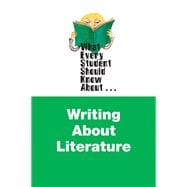
Note: Supplemental materials are not guaranteed with Rental or Used book purchases.
Purchase Benefits
Looking to rent a book? Rent What Every Student Should Know About Writing About Literature [ISBN: 9780205236558] for the semester, quarter, and short term or search our site for other textbooks by Roberts, Edgar V.. Renting a textbook can save you up to 90% from the cost of buying.
Chapter 1: What Is Literature and Why Do We Study It?
Types of Literature
Chapter 2: Reading Literature and Responding to It Actively
Guy de Maupassant, The Necklace
Reading and Responding in a Computer File or Notebook
Guidelines for Reading: Preparation for Writing
Sample Notebook or Journal Entries on Maupassant’s “The Necklace ”
Chapter 3: Discovering Ideas
The Goal of Writing: To Show a Process of Thought
Discovering Ideas (“Brainstorming”)
Study the Characters in the Work
The Need for a Sound Argument in Writing about Literature
Determine the Work’s Historical Period and Background
Analyze the Work’s Economic and Social Conditions
Explain the Work’s Major Ideas
Describe the Work’s Artistic Qualities
Explain Any Other Approaches That Seem Important
Chapter 4: Preparing to Write
Build Ideas from Your Original Notes
Trace Patterns of Action and Thought
Raise and Answer Your Own Questions
Put Ideas Together Using a Plus-Minus, Pro-Con, or Either-Or Method
Originate and Develop Your Thoughts Through Writing
Chapter 5: Make an Initial Draft of Your Essay
Base Your Essay on a Central Idea, Argument, or Statement
Create a Thesis Sentence as Your Guide to Organization
Begin Each Paragraph with a Topic Sentence
Use Your Topic Sentences as Arguments for Your Paragraph Development
Referring to the Names of Authors
Select Only One Topic —No More— for Each Paragraph
Develop an Outline as the Means of Organizing Your Essay
Use Your Outline When Developing Your Essay
Illustrative Essay (First Draft)
Chapter 6: Completing the Essay: Developing and Strengthening Your Ideas Through Revision
Make Your Own Arrangement of Details and Ideas
Use Details from the Work as Evidence to Support Your Argument
Always Keep to Your Point; Stick to It Tenaciously
Try to Be Original
Write with Specific Readers as Your Intended Audience
The Use of Verb Tenses in the Discussion of Literary Works
Use Exact, Comprehensive, and Forceful Language
Illustrative Essay (Improved Draft)
A Summary of Guidelines
Chapter 7: A Short Guide to Using Quotations and Making References in Essays about Literature
Integrate Passages and Ideas into Your Essay
Distinguish Your Own Thoughts from Those of Your Author
Integrate Material by Using Quotation Marks
Blend Quotations into Your Own Sentences
Indenting and Blocking Long Quotations
Use Ellipses to Show Omissions
Use Square Brackets to Enclose Words That You Add within Quotations
Do Not Overquote
Appendix: Documenting Your Work in MLA Style
The New copy of this book will include any supplemental materials advertised. Please check the title of the book to determine if it should include any access cards, study guides, lab manuals, CDs, etc.
The Used, Rental and eBook copies of this book are not guaranteed to include any supplemental materials. Typically, only the book itself is included. This is true even if the title states it includes any access cards, study guides, lab manuals, CDs, etc.